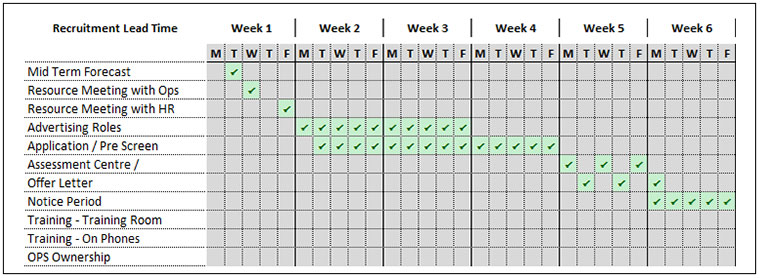Gemma Caddick introduces us to the three types of forecasting timelines most commonly used in the contact centre.
Forecasting contacts allows any resource planner or contact centre manager to effectively plan how many staff they need.
Generally, there are three levels of forecast, although I have spoken to forecasters who only use one or two levels, as well as forecasters who use more than three.
In this article, I am going to focus on the three levels of forecast I use, what the different levels mean, the timescale I apply to each and how the message behind a forecast can easily be lost if not communicated correctly.
Long-Term Forecast
I refer to the long-term forecast as the Budget forecast, as I create it when the business budget plans are being looked at for the next financial year.
To create this forecast, I am looking at:
- The yearly distribution of calls over the previous three years
- The contact increase or reduction trends
Also, it is important to speak to the transformation teams to see what campaigns or projects are being planned and what impact they will have on contact volumes, handle times or shrinkage levels.
I create the forecast at a weekly level and input into a Capacity Plan. The Capacity Plan uses Erlang formulas to convert the forecast into FTE values.
To find out more about Erlang formulas, read our article: Erlang C Formula – Made Simple With an Easy Worked Example
Mid-Term Forecast
This is the forecasting level I see either missed, or not in relation to any particular purpose – other than to update the budget forecast with more up-to-date knowledge.
I think, however, the mid-term forecast can have a much bigger purpose, which all comes down to when it is produced.
Recruitment lead times look at how long it takes from the decision recruitment is needed to the time a new advisor is fully operational.
By understanding how long this process takes, the mid-term forecast – or as I refer to it, “the recruitment forecast” – being planned as the first step in the recruitment lead timeline, can give the business the opportunity to put plans in action for any recruitment needs. These recruitment needs can be created from things such as high attrition or changes to transformation projects.
I create the recruitment forecasts at a weekly level, and input them into our Capacity Plan to view what FTE will be required on the forecast dates.


Comparing the required FTE to the FTE we can expect to have due to attrition trends and known resource movements allows me to make recommendations to contact centre managers for recruitment.
For more on contact centre recruitment, read our article: How Do I… Tune Up the Recruitment Process?
Short-Term Forecast
I refer to this forecast level as the Schedule Forecast, as I am creating it ready to hand over to the schedulers as they generate the schedules.
I have known this forecast level to be created after the schedules have been generated. However, I create this forecast in line with schedule generation. This is because our schedules cannot be changed once the advisors have been given their shifts. For me, any change in forecast after schedule generation would then have a detrimental effect on schedule fit.
The schedule forecast is created at a daily level, split across each skill and interval, using the distribution trends over the last six weeks.
This doesn’t mean I ignore anything that may impact the schedule forecasts once they have been completed. Where necessary, impact assessments will be created to review the impact on contact volumes, which will be advised to Real Time and Operations but not formally changed on the forecast. Using this process holds accountable the cause of the last-minute impact to forecasts.
The schedule forecast is created at a daily level, split across each skill and interval, using the distribution trends over the last six weeks.
To find out how to put a basic schedule together, read our article: How to Work Out How Many Staff You Need in a Contact Centre
Remember That Communication Is Just as Important as Accuracy
With all three levels of forecasting, communication is just as important as the accuracy.
Remember Michael Fish? In 1987, the weatherman denied the possibility of a hurricane but has been notoriously remembered in his career for this inaccurate forecast.
Technically, however, he wasn’t wrong. The message Michael Fish was trying to communicate was that there was a going to be a significant storm; however, the storm couldn’t be classed as a hurricane as it did not originate in the tropics.
The really critical message he was trying to get across was lost, simply because his communication of the forecast focused too heavily on the wrong message… hurricane or no hurricane.
I find that communicating forecasts with FTE values gives a much clearer view of which weeks will be a hurricane and which will be a storm.

Gemma Caddick
I find that communicating forecasts with FTE values gives a much clearer view of which weeks will be a hurricane and which will be a storm.
After all, a high number of calls forecast may in fact need fewer FTE than a lower number of contacts in a different week. This is because AHT and Shrinkage also play a deciding factor in the calculation of FTE.
If plans are only communicated around forecast contact volume, there is the potential to focus too heavily on the wrong message … hurricane or no hurricane.
Thanks to Gemma Caddick, a Forecast Analyst at Severn Trent Water.
For more on the fundamentals of contact centre forecasting, read our articles:
- A Guide to Workforce Forecasting in the Contact Centre
- How to Forecast Demand in the Contact Centre
- How to Calculate Forecast Accuracy
Author: Robyn Coppell
Published On: 16th Apr 2018 - Last modified: 25th Jul 2024
Read more about - Workforce Planning, Erlang Calculations, Forecasting, Full Time Equivalent (FTE), Recruitment, Scheduling



































